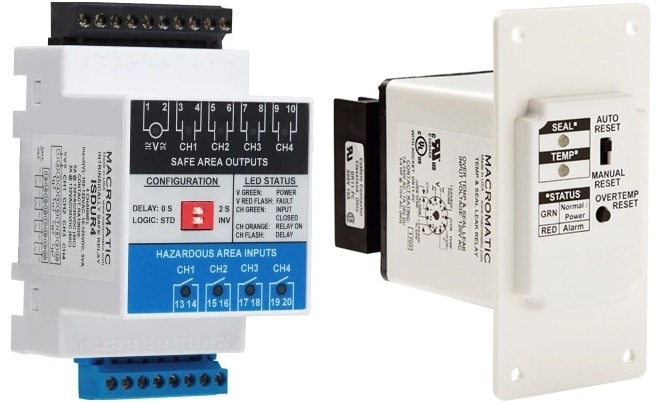New Electrical Relays from MacromaticMay 28 2019
The new over temperature/seal leak relays feature both plug-in style or door mount housings. The door mount style allows the relay to be used without opening a panel door. The TCP series is used with submersible pumps that have resistance sensing to find leaks and has a plug-in style housing. It has voltage ratings of 24V, 120V, or 240V, with a sensitivity range of 4.7 to 100K or 1K to 250K. Sensitivity is adjustable within the preset range. The TCF series has the door mount housing. TCF-E relays are used with pumps that have float type leak detection and the TCF-F series is used for pumps with CLS or FLS leak detection. Voltage ratings are 24V, 120V, or 240V. Both have a switch to select between automatic or manual reset, and the TCF-F series can also indicate a shorted sensor. The new intrinsically safe relays include both a single channel and four channel version. Unlike the existing plug-in style relay, these new models feature DIN-Rail mount housings. Both have universal input voltage and can be used in Class I Groups A, B, C, and D, Class II Groups E, F, and G, and Class III Zone 0 & 1. The ISDUR4 model has a 60mm wide housing and supports up to 4 loads, with 4 modes of operation. It has selector switches to choose the desired mode. The ISEUR1 model has a slim 17.5mm wide housing and supports a single load with a single mode of operation. The PJPU-FA8X is a new three phase monitor relay with a plug-in style housing and universal input voltage. It differs from the existing PMPU-FA8X model in that it trips on three types of phase errors as opposed to five. It trips on phase loss, phase reversal, and undervoltage errors, while giving indication of phase unbalance without tripping. Like the other new relays, it has an LED that will indicate the type of error detected. |
 The line of Macromatic relays offered through Major Electronix has recently expanded. These new relays include over temperature/seal leak relays, intrinsically safe relays, and a phase monitor relay. The over temperature/seal leak relays work with submersible pumps to check for leaks and overheating problems. Intrinsically safe relays are designed for use in hazardous locations. Phase monitor relays are used with three phase systems and check for various types of phase errors.
The line of Macromatic relays offered through Major Electronix has recently expanded. These new relays include over temperature/seal leak relays, intrinsically safe relays, and a phase monitor relay. The over temperature/seal leak relays work with submersible pumps to check for leaks and overheating problems. Intrinsically safe relays are designed for use in hazardous locations. Phase monitor relays are used with three phase systems and check for various types of phase errors.